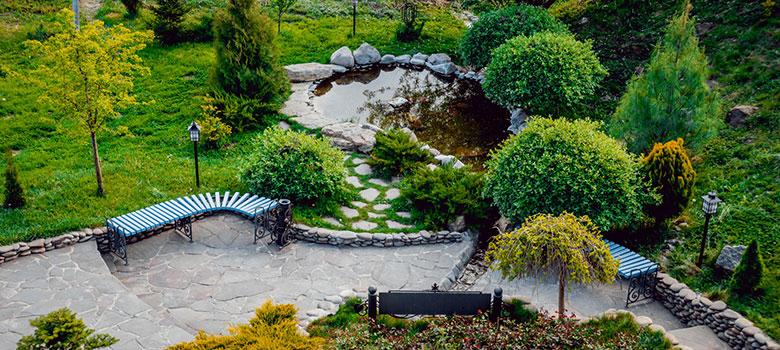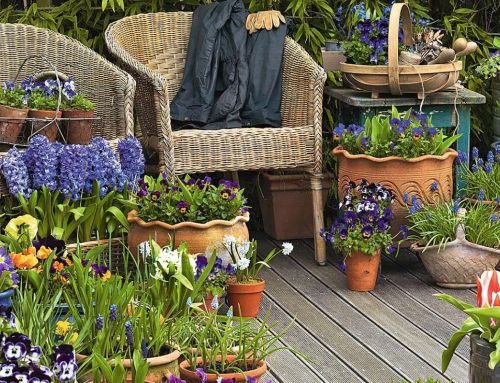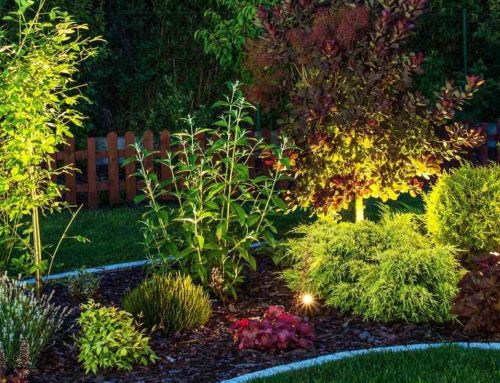This table is a basic guide to help you understand the potential costs involved in various aspects of the project.
Remember, the final cost will depend on the specifics of your project, including the size, materials, design complexity, and labour involved.
The blend of landscape design and hardscaping is not just about creating a garden; it’s about crafting an experience, a retreat that reflects the unique style and needs.
Landscape design is all about the living elements of your outdoor space. It’s the art of arranging plants, trees, and flowers to create a harmonious, visually appealing environment.
Think of it as painting a scene with nature’s palette, where each plant choice and placement plays a crucial role in the overall aesthetics and health of your garden.
Hardscaping, on the other hand, is the backbone of your garden’s architecture. It involves the non-living elements: think paths, walls, decks, and pergolas.
In this guide, we’ll cover:
- Pros and cons of both options
- Comparison of the two options
- Government incentives and warranties
- Making a choice based on your needs
These structures provide form and function, offering both practical solutions and artistic expression. Hardscaping shapes how you interact with your garden, guiding your steps and framing your views.
In this article, we’ll delve into the interplay between these two vital components of garden design. We’ll explore how they complement each other, how they differ, and how, when combined thoughtfully, they can create a stunning outdoor space.
MANNA LANDSCAPES TIPS:
|
Weighing Up Landscape Design and Hardscaping
Landscape Design: Nature’s Symphony
It’s is all about working with the living, breathing components of your garden.
Pros:
- Natural Beauty: The use of plants, trees, and flowers can significantly enhance the aesthetic appeal of your outdoor space, creating a tranquil and inviting environment.
- Environmental Benefits: Plants contribute to a healthier environment by improving air quality, supporting wildlife, and aiding in water management.
- Emotional Wellbeing: A well-designed landscape can offer a peaceful retreat, promoting mental and emotional well-being.
Cons:
- Maintenance: Gardens require regular upkeep, including watering, pruning, and disease control, which can be time-consuming and costly.
- Seasonal Changes: Plant-based landscapes are subject to seasonal changes, which can affect their appearance and require additional care or replanting.
Hardscaping: The Art of Structure
Hardscaping involves the use of non-living elements to add functionality and design to your garden.
Pros:
- Durability and Longevity: Materials used in hardscaping, like stone or concrete, are long-lasting and require minimal maintenance.
- Functional Space: Hardscaping elements like patios and pathways enhance the usability of your outdoor area, allowing for activities like dining or walking.
- Year-Round Appeal: Unlike plants, hardscaping features remain constant throughout the year, maintaining their appearance and functionality regardless of the season.
Cons:
- Initial Cost: The installation of hardscaping elements can be expensive due to the cost of materials and labour.
- Inflexibility: Once installed, hardscaping features are difficult to change or move, requiring careful planning and consideration.
Both options have their unique charms and challenges. Understanding these can help you make informed decisions about your outdoor space, creating a balance that works for your lifestyle and preferences.
Price Guide: How Much Does Landscape Design Cost?
Comparison Landscape Design vs Hardscaping
When it comes to enhancing your outdoor space in Sydney, the choices between landscape design vs hardscaping can be quite nuanced.
Let’s break down these options through key comparison factors, helping you choose the path that aligns best with your needs and vision.
1. Efficiency and Practicality
- Landscape Project: This option requires ongoing attention. Plant care, seasonal gardening tasks, and irrigation are aspects to consider. For those who enjoy gardening, this can be a rewarding, albeit time-consuming, endeavour.
- Hardscaping: Generally more efficient post-installation. Once set up, features like patios or stone pathways require little maintenance, offering a practical and hassle-free solution.
2. Cost and Budget Considerations
- Landscape Project: Initial costs can be lower, especially if you’re starting with basic plantings. However, ongoing maintenance costs should be factored into the budget.
- Hardscaping: Typically involves a higher upfront cost due to materials and installation. But, over time, the low maintenance can make it cost-effective.
3. Durability and Lifespan
- Landscape Project: Plants and trees have varying lifespans and can be subject to environmental impacts. Regular care is essential for longevity.
- Hardscaping: Offers remarkable durability. Materials like concrete, stone, and brick can last for decades with minimal upkeep.
4. Aesthetics and Visual Impact
- Landscape Project: Offers a natural and evolving beauty that changes with seasons, providing a dynamic visual appeal.
- Hardscaping: Brings structural elegance and can be designed to complement architectural styles, offering a consistent aesthetic year-round.
5. Environmental Impact
- Landscape Project: Positively impacts the environment by supporting local ecosystems and improving air quality. The right plant choices can also aid in water conservation.
- Hardscaping: Can have a higher environmental footprint due to the materials used. However, sustainable practices and materials can mitigate this impact.
Additional Considerations
- Flexibility and Adaptability: Landscape designs can be more easily changed or updated than hardscaping elements.
- Resale Value: Both options can enhance property value, but hardscaping often adds more due to its long-lasting nature.
By understanding these factors, you can tailor your outdoor space to not just meet your aesthetic desires but also align with your practical needs and environmental ethos.
Government Incentives and Warranties
It’s important to consider the support available through government incentives and warranties. Here’s what you need to know:
Landscape Design: Embracing Nature’s Palette
City of Sydney’s Greening Strategy focuses on increasing green cover, which includes landscape elements like planting trees and creating green spaces.
The strategy acknowledges the environmental and health benefits of such green spaces, aiming to reduce urban heat, improve air quality, and enhance the liveability of the city.
While direct incentives for individual homeowners aren’t specified, the overall focus on greening suggests support for landscape-oriented projects.
Hardscaping: The Art of Solid Foundations
Business Decarbonisation Support is more broadly aimed at businesses, but it can involve aspects of hardscaping, particularly in the use of low-emission building materials.
Such incentives may not directly apply to residential hardscaping but indicate a trend towards supporting environmentally sustainable practices, including the use of sustainable materials in hardscaping.
Comparison and Clarity
When comparing the two, it seems that while direct incentives or warranties specific to residential areas are not explicitly outlined, there’s a clear governmental focus on environmental sustainability.
This is seen through the encouragement of green spaces in urban areas and support for sustainable practices in construction and design.
Homeowners considering either option should stay informed about local council initiatives and state government schemes, as these can offer indirect support or benefits for both projects.
Get The Facts: Is it Worth Hiring a Landscape Designer?
Choosing Between Landscape Design vs Hardscaping Based on Your Needs
When it comes to deciding between landscape design vs hardscaping for your Sydney home, the choice largely depends on your specific needs, preferences, and the type of installations you’re considering. Here’s a guide to help you make an informed decision:
1. For Creating Relaxing Retreats:
- Landscape Project: Ideal for creating a natural, tranquil environment. Perfect for those who have a green thumb and enjoy the process of gardening. If you’re looking to create a space for relaxation, bird watching, or a nature-inspired escape, landscaping is the way to go.
- Hardscaping: Less suitable for creating a purely relaxing retreat, but can be used to provide structural elements like benches, patios, or gazebos to complement the natural landscape.
2. For Entertaining and Practical Use:
- Hardscaping: Excellent choice for areas meant for entertaining, outdoor dining, or children’s play areas. Durable surfaces like patios or decks are ideal for barbecues and garden parties.
- Landscape Project: This can be incorporated around hardscaped areas to enhance aesthetic appeal but may not be practical as the sole choice for high-traffic entertainment areas.
3. For Small or Challenging Spaces:
- Hardscaping: Highly effective in small or sloped areas where gardening might be challenging. It can provide level surfaces and structured aesthetics.
- Landscape Project: This may require more creative solutions in small or challenging spaces but can be used to create stunning visual effects even in limited areas with the right plant choices.
4. For Low Maintenance Options:
- Hardscaping: A clear winner for those seeking low-maintenance options. Once installed, it requires minimal upkeep compared to gardens.
- Landscape Design: Requires ongoing maintenance such as watering, pruning, and fertilizing.
5. For Environmental Considerations:
- Landscape Project: Better suited for eco-conscious homeowners. Plants and trees contribute positively to the environment by improving air quality and supporting local wildlife.
- Hardscaping: Can be sustainable when using environmentally friendly materials, but generally has a higher environmental impact.
6. For Budget Constraints:
- Landscape Project: This can be more budget-friendly initially but consider the ongoing maintenance costs.
- Hardscaping: Involves a higher upfront cost but is more cost-effective in the long term due to lower maintenance needs.
Your choice between landscape design vs hardscaping should be guided by your lifestyle, the intended use of the space, maintenance preferences, environmental considerations, and budget.
A balanced approach often yields the best results, combining the natural beauty of landscaping with the practicality and structure of hardscaping.
Get the Guide: How to Choose the Best Landscape Designer
Gardens of Delight: Navigating Landscape Design vs Hardscaping Choices
Let’s revisit the key takeaways to guide you in making an informed decision for your outdoor space.
Main Differences:
- Landscape Project: Focuses on the living aspects of your garden – plants, trees, lawns. It’s dynamic, changing with the seasons, and requires regular maintenance.
- Hardscaping: Involves non-living elements – patios, walkways, and walls. It’s static, offering permanence and structure with minimal upkeep.
Pros and Cons:
- Landscape Design Pros: Enhances natural beauty, benefits the environment, and offers therapeutic value.
- Landscape Project Cons: Requires ongoing maintenance and is subject to seasonal variations.
- Hardscaping Pros: Durable, low maintenance, and provides functional outdoor living spaces.
- Hardscaping Cons: Higher initial cost and less flexibility for changes.
Choosing the Right Type:
- Assess Your Lifestyle: If you enjoy gardening and have the time for upkeep, landscaping might be more fulfilling. For a ‘set it and forget it’ approach, hardscaping is preferable.
- Consider Your Space: Smaller or sloped areas might benefit more from hardscaping. Larger areas or those wanting a natural look should consider landscaping.
- Think Long-Term: Consider both the initial investment and ongoing maintenance. Hardscaping might be more cost-effective over time, despite a higher upfront cost.
- Environmental Impact: If environmental sustainability is a priority, landscaping offers more benefits. However, eco-friendly materials can make hardscaping a sustainable choice too.
- Visual Aesthetics: Decide what visual appeal you prefer. Do you want the changing beauty of a garden or the consistent structure of hardscaping elements?
The choice comes down to personal preference, lifestyle needs, and the specific characteristics of your outdoor space.
Many find that a combination of both creates a harmonious and functional outdoor area that offers the best of both worlds.
As you embark on this journey of transforming your outdoor space in Sydney, remember that each choice reflects your personal story and the unique charm of your home.
Whether you lean towards the lush embrace of landscaping or the structured elegance of hardscaping, your outdoor space is a canvas waiting for your creative touch.
Ready to Transform Your Garden? Let’s Get Started!
Whether you’re drawn to the lush allure of a vibrant garden or the sleek sophistication of structured hardscapes, the perfect outdoor oasis is within your reach.
Take the Next Step with Manna Landscapes:
- Personalised Advice: Every space is unique, and so are your preferences. Contact Manna Landscapes for tailored advice that aligns with your individual needs and aspirations.
- Expert Insights: Benefit from the expertise of professionals who understand Sydney’s climate, lifestyle, and trends.
- Get a Custom Quote: Planning within a budget? Get a detailed quote that considers your specific requirements and financial considerations.
Your Dream Garden Awaits:
- Phone: Reach out to Manna Landscapes today at 0415 837 699 to discuss your ideas and how they can help bring them to fruition.
- Request a quote: Prefer writing? Drop an email with your queries, and the Manna Landscapes team will get back to you with their expert recommendations.
Remember, whether it’s a serene green haven or a chic, functional outdoor space, Manna Landscapes is here to help you create a garden that not only meets your desires but also exceeds your expectations.
Don’t wait any longer to transform your outdoor area into a stunning extension of your home.
Contact Manna Landscapes today, and step into the garden of your dreams!



